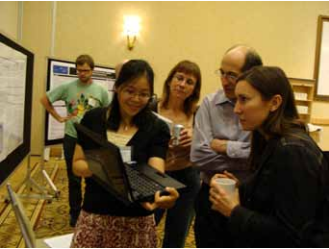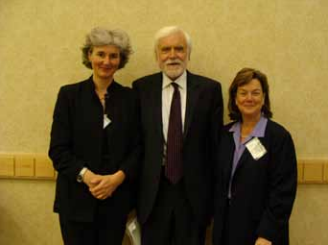In February, thousands of people from all over the globe flocked to Vancouver, BC, Canada, for the 2010 Winter Olympics. The world watched elite athletes demonstrate their skills in various sporting events and show off what they learned in the preceding 4 years.
In much the same way, the medical world was treated to an Olympics of sorts last September when hundreds of international guests met in Vancouver to prove that they—like the athletes—have 4 years of hard work to present. There were friendships and rivalries but, thankfully, no serious injuries.
Organized by the editors of JAMA and the BMJ Group, the Sixth International Congress on Peer Review and Biomedical Publication followed the successful five previous congresses and provided a forum for the presentation, discussion, and debate of new research on many aspects of peer review and scientific publication.
Four hundred twenty-five attendees from 32 countries discussed new research on peer review and the other processes used to evaluate and disseminate medical and scientific information.
The 3-day Congress included 49 plenary-session presentations; each research presentation was followed by discussion and questions from the audience. In addition to the plenary sessions, attendees viewed 64 poster presentations.
Opening Ceremonies
Not all presenters had 4 years to prepare. When the original keynote speaker was unable to attend, last-minute replacement Steven Goodman, of the Johns Hopkins School of Medicine and School of Public Health in Baltimore, MD, remarked that he was inspired by the story of Gioachino Rossini, composer of the opera The Barber of Seville. Rossini famously completed the comedy in less than 2 weeks. “I thought if he could do it in 13 days, I could do it in 10,” Goodman said.
Goodman used humor throughout his presentation to address medical professionals’ tendency to “jump without parachutes”, that is, to embrace a set of results without enough studies to back up the claim. To illustrate the medical community’s changing thoughts, he gave the example of a 1994 study that concluded that owning a refrigerator posed a cancer risk.
Indeed, many of the presentations focused on how research and our faith in the accuracy, quality, transparency, and accountability of published research have changed and what authors and editors can do to improve its quality. Topics included authorship, conflicts of interest, editorial training and ethics, online publishing and new media, peer review, publication bias, publication pathways, quality of reporting, rhetoric, and trial registration.
New Research and Debate
None of the bookish editorial types at the Congress would be accused of taking steroids like some Olympic athletes, but there was some debate about a different kind of deception taking place in journals.
The “Authorship and Contributorship” session hit a nerve with the many attendees. Jason Busse, of the Institute for Work & Health in Toronto, ON, explained how readers might draw false conclusions about study authors’ contributions on the basis of which author in a byline is the corresponding author (for example, first, second, last). Some authors are reluctant to be the designated corresponding author for a study. “No one accepts responsibility unless they’re required to,” commented Congress Director Drummond Rennie.
Honorary and ghost authorship in medical journals also dominated discussions at the Congress. Joseph Wislar and colleagues at JAMA, Chicago, IL, presented research showing that the prevalence of honorary authors (about 20%) had not changed since 1996, but the prevalence of ghost authors had declined from 12% to 8% in six of the world’s leading medical journals. “The prevalence rates of both honorary and ghost authors are much higher than we’d like to see,” said JAMA Survey Research Specialist Wislar. Another presentation, by Jenny White, of the University of California, San Francisco, demonstrated how ghostwriting and guest authors had been used by a pharmaceutical company in articles published in journals as part of a publication campaign to promote a drug.
An-Wen Chan, of the Mayo Clinic in Rochester, MN, discussed financial conflicts of interest in clinical trials and whether investigators of industry-funded and nonindustry-funded trials engage in best practices to mitigate financial conflicts of interest. Chan and colleagues had conducted a survey of Canadian investigators and found that overall 6% of them followed best practices in all their trials; 37% reported having experienced or witnessed financial conflicts of interest, and more than 70% of these situations were related to industry-funded trials.
John M Ellison, of LifeScan, Inc in Milpitas, CA, addressed acknowledgment of company support in research publications on studies supported by pharmaceutical and device companies but led by investigators. His study found that onethird of the company-supported studies did not acknowledge the company support. The lack of acknowledgment may be because the company provided a product that was not the intervention under study or because of journal practices or author preferences. Ellison urged authors and editors to improve the transparency of company-supported publications.
Christine Laine, of Annals of Internal Medicine and CSE president-elect, discussed reproducible research and the willingness of biomedical researchers to share study materials with others. In a study of authors of research articles published in Annals of Internal Medicine, most authors stated that they would make study materials available to others but only if others contacted them first and adhered to specific conditions for sharing the materials.
A surprising presentation by Victoria Wong, of the University of California, Davis Medical Center in Sacramento, showed that medical editors are lacking familiarity with ethical standards. Wong characterized the editors’ demographics, training, experience, and familiarity with scientific-publication ethics. A sample of editors-in-chief of 190 journals received a survey of hypothetical scenarios about plagiarism, authorship, conflicts of interest, and peer review to test their knowledge. Performance on the editorial scenarios was poor, and correct answers were given by only 18% to the question on plagiarism, 30% to authorship, 15% to conflicts of interest, and 16% to peer review. Some 49% believed that additional publication-ethics training would enhance their skills as editors.
A presentation by Benjamin Djulbegovic, of the University of South Florida in Tampa, focused on JAMA’s policy on independent statistical analysis. In July 2005, JAMA implemented a requirement that all industry-funded trials undergo an independent statistical analysis by a statistician with a faculty appointment at an academic center. Djulbegovic and coinvestigators found that the total number of randomized controlled trials (RCTs) and the proportion that had commercial funding decreased significantly in JAMA after the requirement was implemented, whereas the numbers increased in two control journals, the New England Journal of Medicine and The Lancet. Djulbegovic explained that he and his coresearchers cannot tell whether the policy itself affected the number of RCTs submitted, the acceptance rate, or both, and he noted that further research was needed to assess whether the quality of RCTs published before and after implementation of the JAMA policy had changed. Catherine DeAngelis, editor-inchief of JAMA, defended the requirement of independent statistical analysis and concluded by saying that “JAMA will not change unless someone can show us we’re wrong.”
The “Rhetoric” session offered compelling presentations about the use of “spin” in RCTs and research results. Lisa Bero, of the University of California, San Fran-cisco, described research showing how rhetoric is used to overstate the effectiveness of drugs in studies. Isabelle Boutron, of Groupe Hospitalier, Bichat-Claude Bernard, in Paris, France, discussed a study that appraised the strategies of spin used by the authors of reports of RCTs that had statistically nonsignificant primary outcomes to influence readers’ interpretations of the beneficial effects of experimental treatments. The results showed that spin is common, and more than 40% of the reports in the study had spin in at least two of the three sections of the main text. Spin was identified in 18% of the titles, 29% of the results, 43% of the discussions, and 50% of the conclusion sections.
Harold C Sox, former editor-in-chief of Annals of Internal Medicine, noted in a presentation that “journal editing is a public good.” He commented that in addition to questions about funding for open access, attention should be paid to funding for the valuable quality-control and qualityassurance mechanisms used by journals, such as peer review, editorial evaluation, and editing.
A number of research presentations also focused on policies and procedures to improve the reporting of research results. Abstracts of those presentations, as well as of all poster presentations, are available on the Peer Review Congress Web site, www.jama-peer.org.

The final session of the Congress was devoted to postpublication concerns and online publishing, with interesting presentations on the use of online-only features and supplemental content. David Schriger, of Annals of Emergency Medicine and the University of California, Los Angeles School of Medicine, examined the extent to which journals are augmenting print articles with online supplements and functions. In a longitudinal observational cohort study of 138 high-impact medical journals, the number of journals providing online-only supplementary material increased from 32% in 2003 to 64% in 2009. In contrast, the number of journals offering online postpublication review decreased from 12% to 9%. At least one attendee commented that he had hoped to see more research on the effect of online publishing, and Rennie challenged all in attendance to conduct such research for the next Congress.
A Victory?
Rennie began the last day of the Congress by asking attendees whether they thought the Peer Review Congresses were a victory, a defeat, or both. “People think of peer review in very emotional terms,” said Rennie.
He stressed that peer review is a serious business that has serious consequences. “Everyone thinks they have complete editorial freedom until they’re fired,” said Rennie.
Rennie urged attendees to consider the impact of peer view. “What sort of value do editors and peer review add?” Rennie asked. “I believe journals should lead.” He noted that some have called for the Congress to issue standards or guidelines but said that this is primarily a research meeting, not a standard-setting meeting. “Setting up guidelines doesn’t take moments—it takes years,” said Rennie.

Congress Coordinator Annette Flanagin.
Fiona Godlee, European director of the Congress and editor-in-chief of the BMJ, sees the value in the Congress and commented that it “has been a huge influence on the development of peer review and medical journals over the last 20 years. Just getting so many of the world’s editors and peer-review researchers together for an intensive 3 days to examine what we do and share concerns and ideas is incredibly important.”
Godlee added that “the Congress has provided a vital stimulus for research into the state of the medical literature and has spurred us to look critically at what we do and seek better, more ethical, more rigorous ways of doing things. If we, the editors and peer reviewers, don’t evaluate ourselves critically, how can we make any claim to evaluating medical science?”
In the end, there were no winners or losers and ultimately no finish line. Peer review and research into peer review and scientific publication must continue.
As the Congress ended, the hotel lobby filled with old friends hugging each other and new acquaintances exchanging business cards. A few visited the gift shop to buy Olympics souvenirs and Vancouver T-shirts. As the attendees said their good-byes and hauled their bags to the line of waiting taxis, one could already hear talk about what topics should be explored at the next Congress. Rennie urged them not to be disheartened about how much more research is needed: “Work undone is not defeat. I just say ‘Do it!’”
Let the games begin!
Angela Grayson is an assistant editor at JAMA: the Journal of the American Medical Association.
